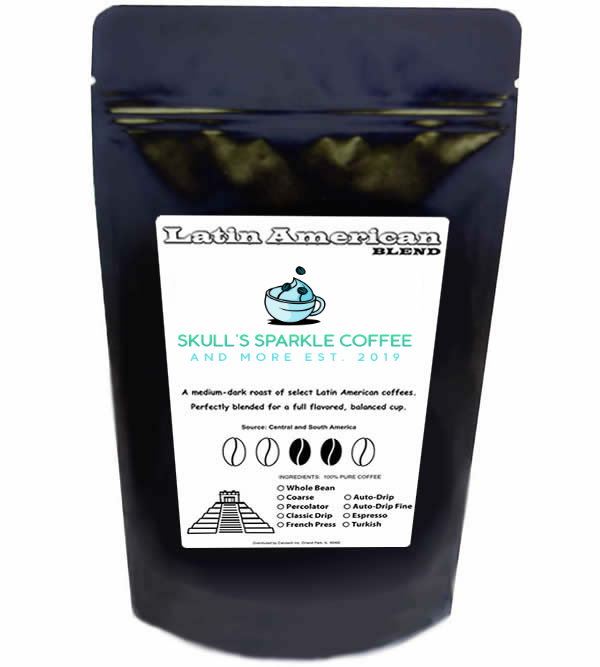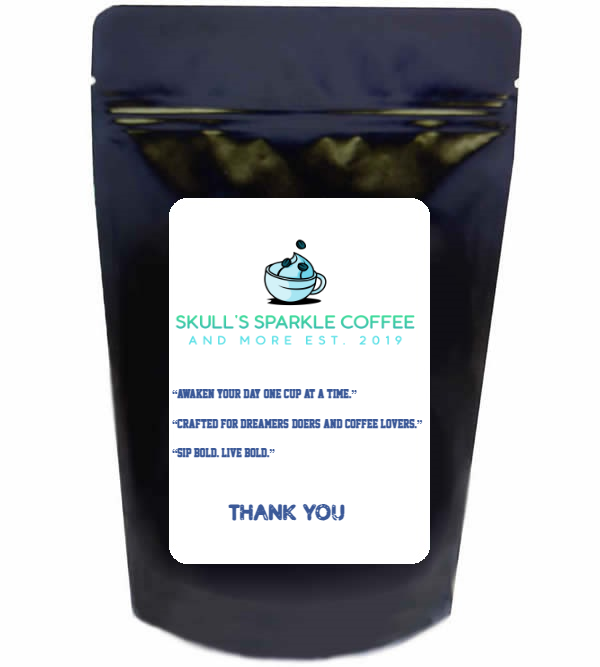SKULL'S SPARKLE COFFEE, TEA AND MORE
Latin American Blend Coffee - I THE SKULL
Latin American Blend Coffee - I THE SKULL
Couldn't load pickup availability
DESCRIPTION
Latin (medium-dark)
Coffee beans are roasted medium-dark for a mix of standard coffee flavor with hints of bold. This Latin American Blend features variable coffee beans blended from Brazil, Mexico, Colombia, Guatemala, Bolivia, Dominican Republic, Honduras, El Salvador and Costa Rica.
Latin American coffee refers to coffee beans that are grown in countries located in Central and South America, including Colombia, Brazil, Costa Rica, Guatemala, Mexico, Peru, and many others. These countries are known for producing high-quality coffee with distinctive flavor profiles.
Latin American coffees are typically grown in mountainous regions with fertile volcanic soil and a tropical climate, which provide ideal growing conditions for coffee trees. The coffee beans from these regions are often classified as “Arabica” beans, which are known for their delicate flavor, lower caffeine content, and higher acidity.
The flavor profile of Latin American coffees can vary depending on the specific country and region of origin. Colombian coffee, for example, is known for its well-balanced flavor with notes of caramel and chocolate, while Brazilian coffee tends to have a nutty and sweet flavor with low acidity. Costa Rican coffee is often described as having a bright, fruity flavor with a hint of citrus, while Guatemalan coffee is known for its complex, spicy flavor with notes of chocolate and caramel.
Many coffee roasters and enthusiasts appreciate Latin American coffee for its nuanced flavor profiles and high quality. In addition, the coffee industry is an important source of income for many countries in the region, and the production of coffee is often deeply ingrained in the cultural and social fabric of these communities.
A medium-dark roast of select Latin American coffees perfectly blended for full flavor, offering nutty hints with mild fruity tones and a gentle cocoa aftertaste. Shade grown in the Central American rain forests and in volcanic soil near the Amazon rain forest, these blended coffees make a rich, delicious cup. Environmentally friendly washed processing and full sun dried for up to 7 days.
ORIGIN COUNTRIES
Brazil
Tasting notes include nutty hints and sweet chocolate. This coffee is grown at an elevation of 3,600 feet in the São Paulo state. It’s popular as a dark roast coffee and makes great espresso with it’s unique espresso type flavors. It’s also a popular blend ingredient for cold brew coffees with a malt texture. Brazil is in South America. The country is located below Colombia and to the east of Peru. Brazil is the world’s largest producer of coffee.
Ingredients: 100% Arabica Coffee.
Colombia
Tasting notes include toffee, apples and a fairly heavy body. This coffee is grown in the Antioquia and Calda regions at elevations between 3,800 and 4,400. Colombia is in South America at its northern tip and borders Ecuador and Venezuela. Nicaragua is to the north.
Ingredients: 100% Arabica Coffee.
Costa Rica
Tasting notes include raisins, walnut and green apples with a medium body. This coffee is grown at an elevation of 5,900 feet in the higher mountain peaks of the Tarrazu growing region of the San Jose province. This province is known for the best coffee beans in the country. The bean variety is Arabica and includes a well balanced mix of Caturra and Catuai varieties. To the west of Tarrazu is the Dota growing region where some world renowned coffee beans are also grown. Costa Rica is in Central America with Nicaragua to the north and Panama to the south. East of the country is the Caribbean Sea and to the west is the Pacific Ocean.
Ingredients: 100% Arabica Coffee
El Salvador
Tasting notes include nuts, chocolate, brown sugar and a heavy body. This coffee is grown at an elevation of 3,600 feet with Arabica bean varieties that include Pacas, Caturra and Bourbon. It is harvested in the Apaneca Mountains where coffee plants are surrounded by fruit trees, offering a perfect shade grown environment. El Salvador is in Central America. Guatemala is to its northwest and Honduras to the northeast. Moving south you would enter Nicaragua.
Ingredients: 100% Arabica Coffee.
Honduras
Tasting notes include caramel, red fruits and chocolate. This coffee is grown at an elevation of 4,500 feet in the Intibuca Department of the Western Highlands. The mountains are full of pine and oak trees, with valleys covered in vegetation due to the tropical soils that are always full of moisture. Honduras is in Central America with Guatemala and Belize to the north. The southern border includes El Salvador and Nicaragua.
Ingredients: 100% Arabica Coffee
Nicaragua
Tasting notes include sweet, citric, caramel and a bright finish with an occasional hint of milk chocolate. This coffee is grown at an elevation of 4,900 feet in the northern part of the Matagalpa region. It’s a mixed Arabica variety of Caturra, Catuai, and Maragogipe coffee beans, which brings this coffee’s unique flavor together. Nicaragua is in Central America just south of El Salvador and Honduras. South of its border is Colombia, the beginning of South America.
Ingredients: 100% Arabica Coffee.
Peru
Tasting notes include chocolate, caramel, almond, raisin and a heavy body. This coffee comes from the central Peruvian province of Huanauco and is grown at an elevation of 6,200 feet. The region was once the home of the Inca Empire. It’s warm in the day and cool at night with an average temperature of 68 degrees Fahrenheit, making it perfect for growing great coffee beans. Peru is located in South America on the western edge, below Colombia and west of Brazil. Bolivia is to its south.
Ingredients: 100% Arabica Coffee.



